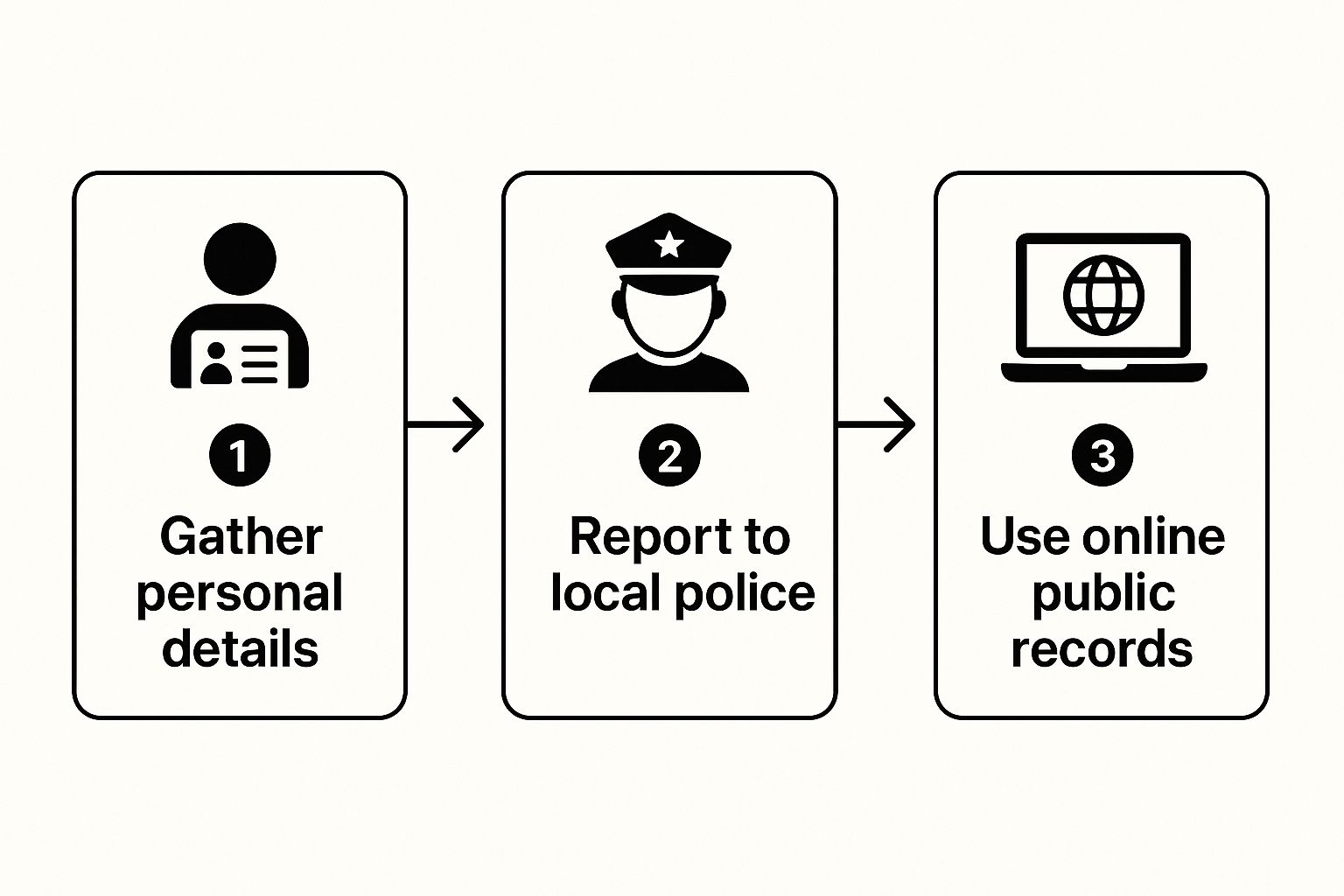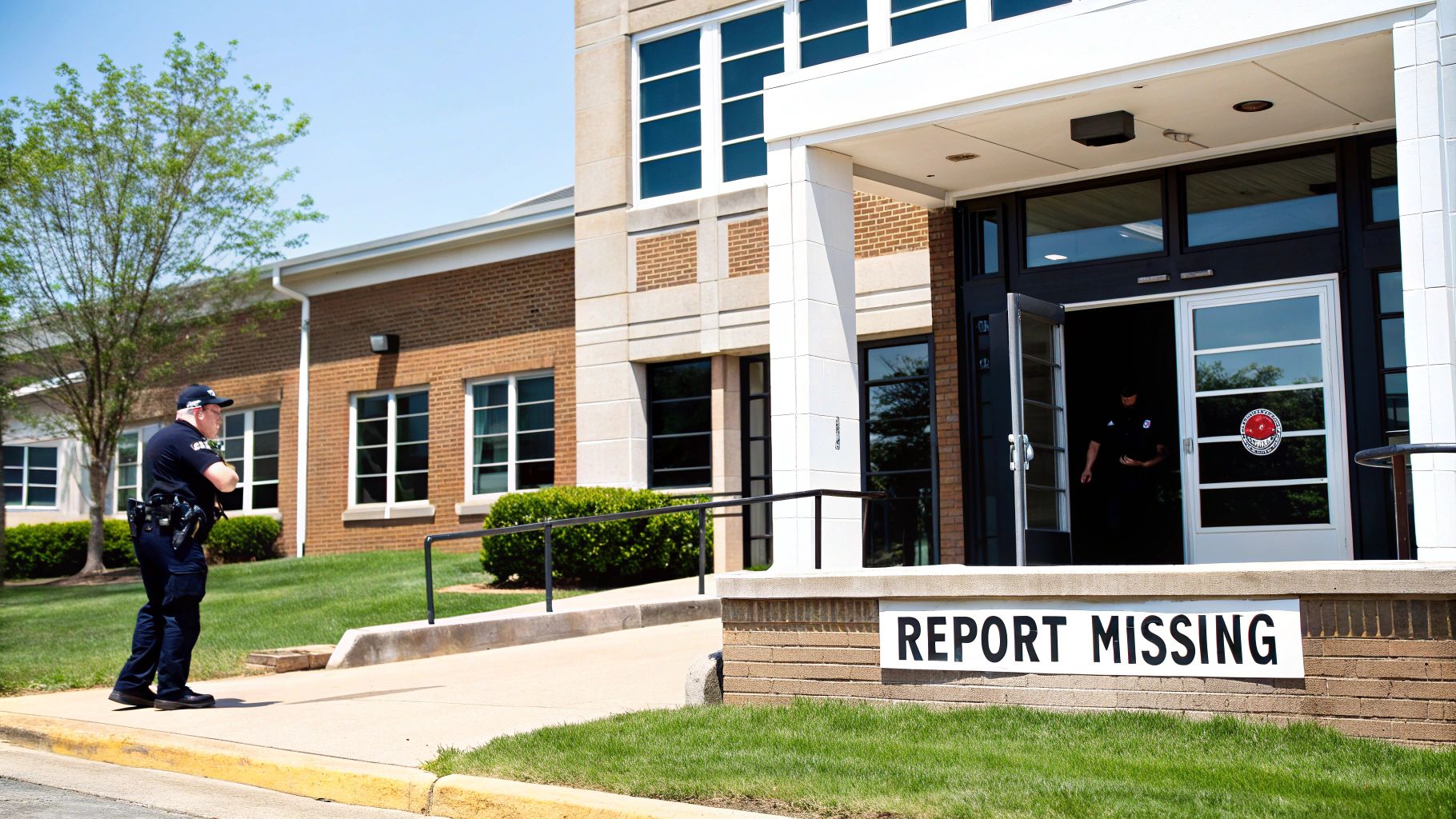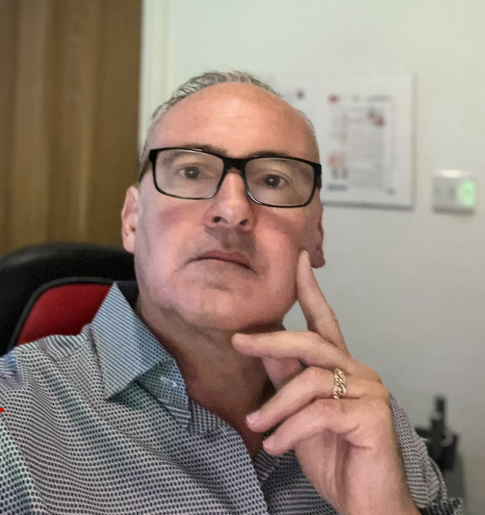When you realise someone is missing, the first myth to bust is that you have to wait 24 hours. That's dangerously wrong. You need to act now. Every single second counts.
Your first moves should be clear and deliberate: gather key information about the person, contact the police immediately, and then let their close friends and family know what's happening. A swift, organised response in these first few moments can make all the difference.
The First Hours: What to Do Immediately When Someone Is Missing
That first wave of panic when a loved one is missing is completely overwhelming, but your ability to stay focused is your most powerful tool right now. The steps you take in these initial hours lay the groundwork for the entire search. It’s not about frantically running in all directions, but about taking methodical, purposeful actions that give the authorities what they need to help.
Think of yourself as the information hub. Your job is to pull together the crucial details that will help everyone piece together their last known movements and whereabouts.

The process is straightforward but vital: get your information organised before the official and public search efforts kick into high gear. This preparation is everything.
Create an Information Toolkit
Before you even dial 999, start putting together a comprehensive file on the person. This "toolkit" will become your go-to reference, saving precious time when you're talking to investigators. You'll be asked for these details over and over, so having them ready helps you stay calm and give accurate information under immense pressure.
Here's what you should include:
- Recent Photographs: Find a few clear, recent photos. You'll want a good headshot showing their face and hair, but a full-length photo is also incredibly helpful.
- Detailed Description: Write down their height, weight, hair and eye colour, and any distinguishing marks like tattoos, scars, or even birthmarks.
- Last Seen Details: This is critical. What were they wearing? Where were they last seen, and at what time? Was anyone with them?
- Key Contacts: Make a list of their closest friends, family members, work colleagues, and anyone else they might reach out to or go to for help.
Your goal is to create a snapshot so clear that a complete stranger could recognise them from it. Don't dismiss the small things—a unique ring they always wear or a specific brand of trainers could be the one detail that cracks the case.
To help you stay focused during this incredibly stressful time, here is a checklist of the most important things to do and information to gather right away.
Immediate Action Checklist
| Action Item | Key Details to Collect | Why It's Important |
|---|---|---|
| Compile Photos | Clear, recent headshot and a full-length photo. | Police and the public need an accurate visual to identify the person quickly. |
| Document Appearance | Height, weight, hair/eye colour, tattoos, scars, birthmarks. | These unique identifiers help distinguish them from others and confirm sightings. |
| Record Last Outfit | Note every item of clothing, including shoes and accessories. | Specific clothing is one of the easiest details for witnesses to recall. |
| Pinpoint Last Location | Exact address or area, time, and who they were with. | This establishes the starting point for the police search and investigation. |
| List Key Contacts | Friends, family, and colleagues' names and phone numbers. | These individuals may have crucial information or could be the person's destination. |
| Note Medical Needs | Any required medication, mental health conditions, or vulnerabilities. | This information determines the urgency and type of police response needed. |
Having this table filled out and ready to go will streamline your conversation with the police and ensure no vital information is missed.
Understanding the Urgency
In the UK, around 180,000 people are reported missing each year. The good news is that most are found quickly; statistics from the charity Missing People show 80% of children and 76% of adults are located within 24 hours.
But that statistic also highlights why immediate action is so important. The chances of finding someone safe and well are highest in those very early stages.
Certain circumstances will automatically raise the alarm for police, and you must communicate them clearly. These factors can escalate a case to a high-risk level, triggering a more significant response. Make sure you mention if the person:
- Has a known medical condition that requires medication (like diabetes or a heart condition).
- Struggles with their mental health, such as depression, anxiety, or has expressed suicidal thoughts.
- Lives with a condition like dementia or Alzheimer’s, which could leave them confused and disorientated.
- Is a child or a vulnerable adult.
These aren't just minor details; they are critical risk factors that change everything. For example, a person with dementia might be trying to get to a childhood home and could be in real danger. Communicating that context helps the police allocate the right resources from the very start.
While the police will always lead the official investigation, many families find themselves looking for additional support. If you want to understand how professionals can step in, you can learn more by reading our guide on hiring a private investigator to find a missing person.
Reporting a Missing Person and Working with the Police
Taking that first step to file an official police report is a huge moment. It can feel daunting, but it's the point where the formal search truly begins. With the initial information you've gathered, you're ready to get the authorities involved. Understanding how they work will make you a much more effective partner in the search for your loved one.

This might look like a standard procedural graphic, but what it represents is crucial. It shows that UK police forces operate under a national, professional framework. Your report won't just disappear into a void; it triggers a structured, protocol-driven response designed to assess risk and act accordingly.
The police don't just improvise. They follow a detailed process to classify the case and decide what resources to put into it. Knowing what they need helps you give them the right details from the very start.
Making the Call: 999 vs 101
The first choice you'll make is which number to dial. It all comes down to how much danger you believe the person is in, right now.
- Dial 999 if: The situation feels critical. This is for any missing child, a vulnerable adult, or if you have a genuine fear they are in immediate danger of harm (e.g., risk of self-harm, a medical emergency, or a suspected abduction).
- Dial 101 if: There's no immediate threat to life. Perhaps you've lost touch with an adult relative over a period of time and have no specific reason to believe they're in imminent danger.
Whichever number you call, the operator will run through a list of questions. It can feel a bit blunt, but they are trained to quickly gather the essential facts to build a report and gauge the urgency. Have the details you’ve already collected ready to go – their description, where they were last seen, and any known vulnerabilities.
How Police Assess Risk Levels
After you file the report, the police will immediately categorise the case based on risk. This is the single most important factor determining the speed and scale of their response. This risk level isn't set in stone; it can be upgraded or downgraded as new information surfaces.
The three main categories are:
- High Risk: This means there's a credible, immediate threat to the person's life or safety, or to the public. These cases trigger a major, urgent investigation.
- Medium Risk: The person is likely facing some level of risk, but it’s not considered immediate. The police response is still significant, just not at the same emergency level as a high-risk case.
- Low Risk: On the face of it, the person doesn't seem to be in any obvious danger. The case is still investigated, but with fewer resources assigned at the outset.
This is why it's so important to be completely open about any mental health issues, medical needs, or strange circumstances. That information directly shapes the risk assessment and ensures the police give the search the priority it deserves. For a more detailed look at what to expect, have a read of our guide on the missing person police report procedure.
The scale of missing person investigations in the UK is enormous, with police handling around 330,000 incidents every year. The framework they operate under is strict. For example, officers are prohibited from using their personal social media accounts to poke around, as it could compromise the investigation. Instead, they must obtain specific surveillance authority for any online monitoring. You can learn more about these intricate legal guidelines on the College of Policing website.
The Role of the Family Liaison Officer
In particularly complex or high-risk cases, the police may assign a Family Liaison Officer (FLO) to you. This officer becomes your single, dedicated point of contact.
Their job isn't to lead the investigation itself, but to act as a bridge between you and the investigative team. A good FLO is invaluable. They provide regular updates, translate police jargon, and ensure you’re not left feeling lost or ignored during an incredibly difficult time. They can also point you towards charities and support services that offer vital practical and emotional help.
Using Social Media and Community Support Safely
Once the police have been informed and their investigation is officially underway, you can begin to rally support from the community. Social media and local networks are incredibly powerful tools, but you have to handle them with care. The last thing you want is to accidentally hinder the police investigation or cause more distress.
Your goal here is to create a responsible, helpful extension of the search, not an uncontrolled wave of speculation.

A well-crafted digital appeal can reach thousands of eyes in minutes. But get it wrong, and it can quickly become counterproductive, spreading misinformation or even putting the missing person at greater risk.
Creating an Effective Missing Person Poster
Before you post a single thing online, your first job is to create a clear and simple missing person poster or digital graphic. This is the bedrock of your appeal. Its design needs to be all about clarity, making sure the most vital information jumps off the screen.
Put yourself in the shoes of a stranger seeing it for a split second. What do they absolutely need to know? A face, a name, and who to contact.
These elements are non-negotiable:
- A Clear, Recent Photo: A high-quality headshot is best. Make sure their face is clearly visible – no sunglasses, hats, or group shots that cause confusion.
- Key Information: Include their full name, age, height, build, and any really distinctive features like tattoos or noticeable scars.
- Last Known Details: Be specific. State the date, time, and location where they were last seen. A description of the clothes they were wearing is also incredibly helpful.
- Official Contact Information: This is critical. Direct all information to the police. Provide the name of the police force, the incident number, and the 101 or 999 phone number. Under no circumstances should you put your personal phone number on a public poster.
That last point is a hard and fast rule. Sharing your own details can open the door to deeply distressing prank calls, scams, and a flood of unverified tips that should be going directly to the investigators. It also protects your own privacy during an incredibly vulnerable time.
Navigating Social Media Appeals
With your poster ready, you can put together a social media post. The tone you're aiming for is urgent but calm. Just state the facts and steer clear of overly emotional language, as this can sometimes fuel unhelpful speculation. Make sure the post is public so it can be easily shared.
When you're ready to launch the appeal, think about where it will be most effective:
- Facebook: Absolutely brilliant for sharing in local community groups, neighbourhood watch pages, and regional news forums. The share function is incredibly powerful for getting the message out locally.
- X (formerly Twitter): Great for reaching journalists and local authorities. Using relevant hashtags (like #MissingManchester or #FindJohnDoe) can dramatically increase its visibility.
- Instagram: As a visual platform, it’s perfect for sharing the poster. Instagram Stories are particularly good, as people can repost them with a single tap.
Pro Tip: Having a single, central post that everyone shares is far more effective than lots of different versions floating around. Ask one trusted family member or friend to be the designated person for posting all updates. This keeps the information consistent and credible.
Managing the response is just as important as crafting the initial post. You’ll likely get a lot of comments and private messages. You need to monitor these for any genuine leads – which should be passed immediately to the police – but you also have to be ready to hide or delete comments that are speculative, abusive, or spreading rumours. Learning about effective member engagement strategies for community participation can be surprisingly helpful here.
When creating and sharing your appeal, it's vital to protect both the missing person and your family. Here's a quick guide to what you should and shouldn't include.
Safe and Effective Social Media Appeals
| Information to Include | Information to Omit (for safety/privacy) | Action for Engagement |
|---|---|---|
| A clear, recent photo | Personal contact details (phone, email, home address) | Ask people to share the post on their own feeds. |
| Full name and age | Sensitive personal details (medical conditions, financial issues) | Tag relevant local news outlets and community groups. |
| Last known location, date, and time | Speculation about why they went missing | Use clear, location-specific hashtags (e.g., #MissingLondon). |
| Description of clothing | Unverified sightings or rumours | Provide a clear call to action: "If you see them, call 999." |
| Official police incident number | Details of family disputes or personal conflicts | Thank the community for their help and shares. |
Always be wary of messages from people claiming to have information, especially if they start asking for money – scammers are known to prey on the desperation of families in these situations. You might also receive anonymous tips. While services exist that can help with tracing telephone numbers in the UK, your first and only call should be to the police to pass on the information.
Finally, always try to coordinate with the police before launching a massive public appeal. In some high-risk cases, they might have specific reasons for controlling the flow of information, particularly in the early stages. A collaborative approach ensures your efforts are a help, not a hindrance.
Understanding Why People Go Missing

To have any real chance of finding someone, you have to try and see the world through their eyes. People don't just vanish. Their disappearance is almost always tied to something complex and deeply personal going on in their lives.
Thinking about these possibilities isn't about jumping to conclusions or panicking. It's about being practical. Having this context helps you give the police the right kind of information and allows everyone to focus the search where it’s most likely to yield results.
Mental Health and Emotional Crises
A significant number of missing person cases are linked to mental health. When someone is in the grips of severe depression, anxiety, or another serious condition, their thinking can become clouded, leading them to leave home without a word. They might feel completely overwhelmed, and running away feels like the only escape.
In these situations, a person might head to a place that once brought them comfort, like a park they loved as a child or an old part of town. On the other hand, they could do the opposite and seek total isolation. This is why it’s so critical to share any known mental health history with the police; it immediately shapes their risk assessment and search strategy.
The connection between mental health and vulnerability is something authorities take very seriously. You can read more about the official frameworks for missing persons in the UK to understand how they approach these delicate situations.
Dementia and Cognitive Impairment
For older adults, dementia is a common and truly heart-breaking reason for going missing. It’s estimated that around four out of ten people with dementia will get lost at some point, often more than once. This isn't a choice; it's a symptom of their illness.
They might be trying to get to a job they left decades ago or searching for a childhood home. Their journey might not make any logical sense to us, but it does to them. This is where schemes like The Herbert Protocol come in—it’s a simple form you fill out with key information that can be handed straight to the police, saving vital time if the worst happens.
Someone with dementia often doesn't realise they're lost. They might just seem confused or a bit disoriented. Knowing their personal history—favourite walks, old addresses, former workplaces—gives you a massive head start in figuring out where they might have gone.
Exploitation and External Pressures
Sometimes, a person’s disappearance isn't entirely their own decision. They might be under the influence of someone else or running from a situation they see no other way out of. This is a real risk for young people and other vulnerable adults.
You have to consider some difficult possibilities:
- Criminal Exploitation: Young people can be drawn into "county lines" drug operations, forced to travel and transport illegal substances.
- Domestic Abuse: A person may have fled an abusive partner or family and will be actively trying to stay hidden for their own safety.
- Modern Slavery: Some are lured away by false promises of a job or a new life, only to find themselves trapped and exploited.
These are incredibly delicate scenarios. If you have even the slightest suspicion that exploitation is involved, you must tell the police right away. It changes everything, turning the case from a standard search into a potential criminal investigation.
When official channels feel slow, some families look into what private investigators do. A professional can often uncover details and connect dots in a way that provides much-needed clarity.
For a deeper understanding of their methods, you can learn more about what private investigators do.
Getting Specialist Support and Tapping into UK Resources
Trying to find a missing loved one is an incredibly difficult and emotionally draining time. It’s important to remember you aren't expected to go through this alone. Right across the UK, there’s a network of specialist organisations offering free, confidential support designed specifically for families in your situation. These groups can offer practical help, a shoulder to lean on, and a vital sense of community when you need it most.
Leaning on this support isn't a sign of weakness—far from it. It's a smart and necessary step to look after your own wellbeing during the search. These people truly understand what you're going through and have the experience to help you handle the immense uncertainty and stress.
The Central Role of the Missing People Charity
At the very heart of this support network is the charity Missing People. They are the only national charity in the UK dedicated solely to this cause, providing a lifeline for families 24 hours a day. All their services are completely free, offering a crucial mix of practical search assistance and much-needed emotional support.
Their team can help you think clearly about what to do next, offer a listening ear when it all feels too much, and even connect you with other families who have walked this path before. Getting to know what they offer is a fundamental part of building your support system.
Here are a few of the core services they provide:
- A Free 24/7 Helpline: You can call them anytime on 116 000 for confidential advice and a chat. This number is free to call from any phone.
- Publicity Appeals: They have an incredible network and can help you create and share a missing person poster on billboards, online, and through social media.
- Family Support: They offer one-to-one emotional support, access to counselling, and regular group sessions where you can connect with others in the same boat.
- TextSafe® Service: This is a clever system that allows a confidential message to be sent to the missing person's phone, giving them a safe way to get in touch.
This screenshot from their website gives you a sense of the immediate, accessible help they offer. It’s all laid out simply, designed to be easy to find what you need during a crisis so you can get support quickly.
Broader Mental Health and Practical Support
The reasons people go missing are often complex and can be tied to wider issues. Because of this, other organisations can also play a really important role in offering support, both for you and potentially for the person you're looking for.
If you’re worried about their mental state, charities like Mind and the Samaritans offer expert advice and non-judgmental listening services. Their helplines aren’t just for people in crisis, but also for family and friends who are worried about someone's wellbeing.
It's absolutely vital to remember that looking after yourself isn't a distraction from the search; it’s what gives you the strength to continue. Burnout is a very real risk, and these services are there to help you avoid it.
For younger people, organisations like The Children's Society and the Runaway Helpline provide specialist support tailored for children and teenagers who have run away from home.
Managing Practical and Financial Affairs
When an adult is missing for a long time, tough practical questions start to surface. How are their bills going to be paid? Who will manage their mortgage or rent? Thankfully, the UK has specific legislation to help with this.
The Guardianship (Missing Persons) Act 2017, often known as Claudia's Law, allows you to apply to the High Court to become a guardian of the missing person's property and financial affairs. It can be a complex process, but it's there to protect their assets and prevent further distress for the family. You'd typically need legal advice to go down this route, and charities can often point you towards pro bono legal services. While it's a step nobody ever wants to consider, just knowing it exists can bring some reassurance in long-term cases.
Sometimes, the police investigation might not be moving as fast as you'd hope. When that happens, it’s natural to want to explore every single avenue. If you feel you need more direct, hands-on help, professional services can show you how to trace a person using specialist techniques.
Your Questions Answered: Finding a Missing Person
When someone you care about disappears, your head is suddenly filled with a hundred urgent questions. It’s a bewildering time, and getting clear, straightforward answers is crucial. Here, we'll tackle some of the most common queries we hear from families, giving you the practical information you need to navigate the days ahead.
Think of this as a quick reference guide. It’s here to cut through the confusion and help you understand the process, manage your expectations, and know what to do next.
What Happens If the Police Say the Case is "Low Risk"?
Hearing the term 'low risk' can be incredibly frustrating. It can feel like the police aren't taking the situation seriously, but that’s not what it means. A low-risk classification simply indicates that, based on the initial facts, there's no immediate evidence to suggest the person is in grave danger.
This doesn't mean your report is sitting in a pile on someone's desk. The police will still take action. Standard procedure for a low-risk case typically involves:
- System Checks: Running the person's name through national police databases to check for any recent contact with officers elsewhere in the country.
- Local Enquiries: Calling nearby hospitals and A&E departments to see if anyone matching the description has been admitted.
- Visiting Key Locations: Officers might visit the person's last known address or other places they frequent.
Crucially, this risk level isn't set in stone. It can be upgraded in a heartbeat. If you receive a strange text, remember they missed vital medication, or learn anything else that heightens your concern, tell the police straight away. That new piece of information could be exactly what’s needed to escalate the official response.
Can I Hire a Private Investigator While the Police Are Also Looking?
Yes, absolutely. Bringing in a private investigator is a personal decision and it won’t get in the way of the police investigation. In reality, the two can work in tandem, providing a two-pronged approach to the search.
A private investigator offers a dedicated resource focused solely on your case. While the police are often juggling numerous urgent priorities, a PI can dig deeper into avenues that might otherwise be overlooked. They can spend hours sifting through CCTV, interviewing potential witnesses, or following up on leads that may seem minor. It’s about complementing the police’s work, not replacing it. The golden rule is to ensure any solid information your investigator uncovers is passed directly to the police liaison officer.
How Long Does a Missing Person Case Stay Open?
In the UK, a missing person investigation is never closed until the individual is found. There is no deadline or cut-off point. The file remains open indefinitely, even if the active, on-the-ground search is eventually scaled back.
Police forces periodically review all their long-term missing person cases. This means that years down the line, a breakthrough in technology or a newly discovered piece of information can breathe new life into an investigation. Hope is never written off.
This long-term policy ensures that no one is forgotten. If a new lead surfaces—whether it's six months or sixteen years later—the case is there, ready to be acted upon.
What Should I Do If the Missing Person Contacts Me?
If you get that call or message, the first thing to do is take a deep breath. Your priority is their immediate safety. Listen calmly, without judgment, and let them know they are loved and that help is available, no matter what has happened.
Once you’ve spoken to them, you have two very important responsibilities:
- Tell the Police Immediately: You must let the police know that contact has been made. This is vital for closing the official missing person report. They need to know the person is safe.
- Respect Their Wishes (within reason): If the person is a vulnerable adult, the police will need to physically see them to verify their safety. However, if they are an adult of sound mind who has chosen to leave, they have a right to privacy. The police will confirm they are safe and well, but they will not disclose their location to you without their explicit permission.
At UK Private Investigators, we know the agony and helplessness that comes when a loved one is missing. Our team of experienced professionals provides discreet and dedicated support to help find the answers you deserve. If you need specialist assistance, visit us at https://www.ukprivateinvestigators.com to see how we can help.

